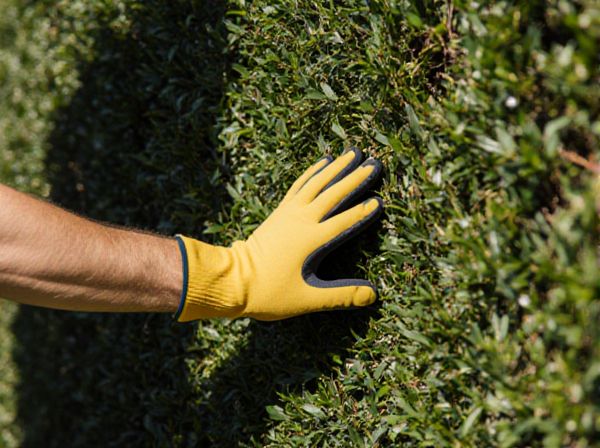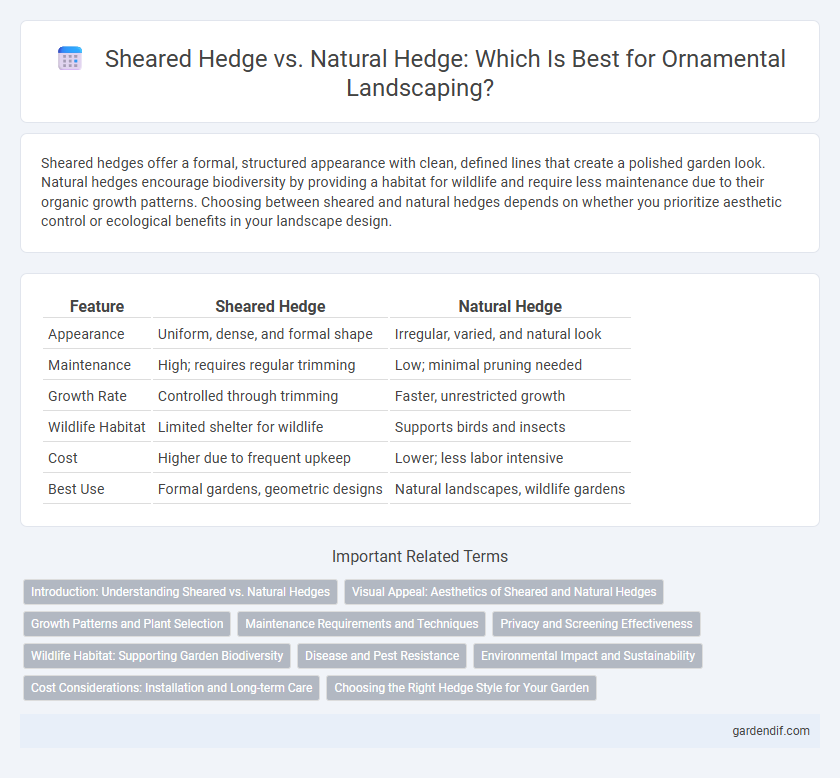
Sheared Hedge vs Natural Hedge Illustration
Sheared hedges offer a formal, structured appearance with clean, defined lines that create a polished garden look. Natural hedges encourage biodiversity by providing a habitat for wildlife and require less maintenance due to their organic growth patterns. Choosing between sheared and natural hedges depends on whether you prioritize aesthetic control or ecological benefits in your landscape design.
Table of Comparison
| Feature | Sheared Hedge | Natural Hedge |
|---|---|---|
| Appearance | Uniform, dense, and formal shape | Irregular, varied, and natural look |
| Maintenance | High; requires regular trimming | Low; minimal pruning needed |
| Growth Rate | Controlled through trimming | Faster, unrestricted growth |
| Wildlife Habitat | Limited shelter for wildlife | Supports birds and insects |
| Cost | Higher due to frequent upkeep | Lower; less labor intensive |
| Best Use | Formal gardens, geometric designs | Natural landscapes, wildlife gardens |
Introduction: Understanding Sheared vs. Natural Hedges
Sheared hedges feature precise, uniform shapes achieved through regular trimming, enhancing formal garden designs with clean lines. Natural hedges grow with minimal pruning, promoting wildlife habitats and organic aesthetics favored in eco-friendly landscapes. Choosing between sheared and natural hedges involves balancing maintenance levels, desired appearance, and ecological benefits.
Visual Appeal: Aesthetics of Sheared and Natural Hedges
Sheared hedges provide a clean, formal appearance with crisp edges and uniform shapes that enhance structured garden designs. Natural hedges offer a softer, organic aesthetic characterized by varied textures and irregular growth patterns, appealing to wildlife and blending seamlessly with natural landscapes. Both hedge styles contribute distinct visual appeal, allowing customization based on garden style and desired ambiance.
Growth Patterns and Plant Selection
Sheared hedges exhibit uniform growth patterns achieved through regular pruning, favoring dense, slow-growing species like boxwood and yew that respond well to shaping. Natural hedges showcase irregular growth with seasonal variations, often composed of mixed native plants such as hawthorn and holly that support biodiversity. Selecting the appropriate hedge type depends on landscape goals, balancing aesthetic control with ecological benefits.
Maintenance Requirements and Techniques
Sheared hedges require regular trimming, typically every 4 to 6 weeks during the growing season, using manual or electric shears for a uniform and formal appearance. In contrast, natural hedges demand less frequent pruning, usually once or twice a year, relying on selective branch removal to maintain health and shape while encouraging natural growth patterns. Proper maintenance of both types involves monitoring for pests and diseases, watering adequately, and applying mulch to retain soil moisture.
Privacy and Screening Effectiveness
Sheared hedges offer a dense, uniform barrier that maximizes privacy and provides superior screening effectiveness by eliminating gaps and irregularities. Natural hedges, while aesthetically pleasing and supportive of biodiversity, usually have uneven growth patterns that can reduce their ability to fully block views and noise. For optimal privacy and screening, especially in urban gardens, sheared hedges remain the preferred choice due to their controlled shape and thickness.
Wildlife Habitat: Supporting Garden Biodiversity
Sheared hedges provide a dense, uniform structure that offers limited nesting spaces for birds and insects, reducing wildlife habitat diversity. Natural hedges with irregular growth patterns support a wider range of flora and fauna by preserving flowering and fruiting stages essential for pollinators and small animals. Maintaining natural hedges enhances garden biodiversity by creating varied microhabitats that promote ecological balance and sustain local wildlife populations.
Disease and Pest Resistance
Sheared hedges often have reduced air circulation and dense foliage, making them more susceptible to fungal diseases such as powdery mildew and leaf spot, as well as pest infestations like aphids and spider mites. Natural hedges maintain better airflow and light penetration, which enhances their ability to resist common pests and diseases by creating a less favorable environment for pathogen development. Selecting disease-resistant shrub species for natural hedges further improves their resilience, reducing the need for chemical treatments and promoting healthier ornamental landscapes.
Environmental Impact and Sustainability
Sheared hedges require frequent trimming, resulting in higher energy consumption and increased carbon emissions due to regular maintenance equipment use. Natural hedges promote biodiversity by providing habitats for wildlife and improving soil health through less disturbance. Sustainable landscaping favors natural hedges for their lower ecological footprint and enhanced ecosystem benefits.
Cost Considerations: Installation and Long-term Care
Sheared hedges often require higher initial installation costs due to precise shaping and labor-intensive pruning techniques, whereas natural hedges typically have lower upfront expenses as they demand less frequent trimming. Long-term care for sheared hedges involves consistent maintenance costs related to regular trimming, pest control, and nutrient management to preserve their structured appearance. Natural hedges incur reduced ongoing maintenance expenses, benefiting from more organic growth patterns and lower pruning frequency, making them a cost-effective option over time.
Choosing the Right Hedge Style for Your Garden
Sheared hedges offer a formal, sculpted appearance that enhances geometric garden designs, providing clean lines and uniform height ideal for structured landscapes. Natural hedges promote biodiversity by attracting wildlife and require less maintenance, making them suitable for informal, ecological gardens. Selecting the right hedge style depends on your garden's overall aesthetic, desired maintenance level, and environmental considerations.
Sheared Hedge vs Natural Hedge Infographic

 gardendif.com
gardendif.com